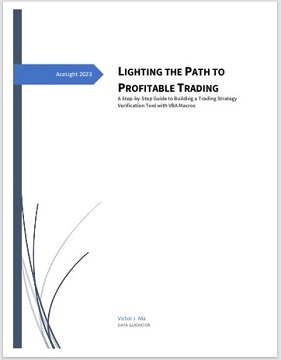Different Types of Stock Trading Strategies
|
|
As the famous saying goes, "Buy low, sell high" – it sounds simple enough,
right? Well, if stock trading was as easy as that, we'd all be millionaires
by now! Let's face it: stock trading can be a bit of a rollercoaster ride.
One day you're up, the next day you're down, and sometimes you're left
wondering if you should just close your eyes and hope for the best. But fear
not, my friends! There are many different types of stock trading strategies
out there to help you navigate the ups and downs of the market, and maybe
even have a little fun along the way (if you're into that sort of thing). So
let's buckle up, put on our trading hats, and explore the wild and wonderful
world of stock trading strategies!
Stock trading is a popular way to
invest in the stock market and potentially earn profits. There are many
different types of stock trading strategies that traders can use to achieve
their investment goals. In this blog post, we will explore some of the most
common types of stock trading strategies.
1. Long-term vs. Short-term
Trading
Long-term trading involves holding stocks for an extended
period, usually years or decades. This strategy is based on the belief that
the stock market will continue to grow over time, and that by holding stocks
for the long-term, investors can benefit from the overall upward trend in
the market. Long-term traders typically focus on buying stocks with solid
fundamentals and holding them for the long-term.
Short-term trading,
on the other hand, involves buying and selling stocks over a shorter period,
usually weeks or months. This strategy is based on the belief that
short-term price fluctuations in the market can be exploited to generate
profits. Short-term traders typically use technical analysis and charting to
identify short-term trends and trading opportunities.
2. Fundamental
vs. Technical Analysis
Fundamental analysis involves analyzing a
company's financial statements, earnings reports, and other data to
determine its intrinsic value and potential for growth. This type of
analysis is used by long-term traders to identify undervalued stocks with
strong fundamentals and growth potential.
Technical analysis, on the
other hand, involves analyzing stock price charts and other technical
indicators to identify trading opportunities. This type of analysis is used
by short-term traders to identify short-term price trends and patterns that
can be used to make profitable trades.
3. Discretionary vs.
Systematic Trading
Discretionary trading, also known as manual
trading, involves human traders using their judgment and experience to make
decisions on which trades to execute. This type of trading is often used by
experienced traders who rely on a combination of fundamental and technical
analysis to identify trading opportunities.
Systematic trading (or
Quantitative trading), also known as algorithmic trading or Automatic
trading, involves using computer programs or algorithms to execute trades
automatically based on pre-defined rules and conditions. This type of
trading is often used by institutional investors and hedge funds to execute
large-volume trades quickly and efficiently.
4. Day Trading vs. Swing
Trading
Day trading involves buying and selling stocks within the
same day, with the goal of profiting from short-term price fluctuations.
This type of trading requires a high level of skill and discipline, as
traders must make quick decisions based on real-time market data.
Swing trading, on the other hand, involves holding stocks for several days
or weeks, with the goal of profiting from longer-term price trends. This
type of trading allows for more flexibility and less stress than day
trading, but still requires a strong understanding of technical analysis and
market trends.
5. Value Investing vs. Growth Investing
Value
investing involves identifying undervalued stocks with solid fundamentals
and growth potential. This strategy is based on the belief that the market
sometimes undervalues certain stocks, providing opportunities for savvy
investors to buy in at a discount.
Growth investing, on the other
hand, involves investing in stocks with strong growth potential, even if
they may be overvalued in the short-term. This strategy is based on the
belief that investing in companies with strong growth potential can lead to
higher long-term returns.
6. High Frequency Trading (HFT) vs. Low
Frequency Trading (LFT)
High frequency trading involves the use of
powerful computers and algorithms to execute trades at lightning-fast
speeds. HFT strategies rely on advanced quantitative models and real-time
market data to identify trading opportunities and execute trades within
microseconds. This type of trading is typically used by large institutional
investors and hedge funds to generate profits from small price movements in
the market.
Low frequency trading, on the other hand, involves taking
a longer-term approach to trading, with trades being executed over a period
of days, weeks, or even months. LFT strategies typically rely on fundamental
analysis and long-term trends in the market, rather than short-term price
fluctuations, to identify trading opportunities. This type of trading is
often used by individual investors and smaller hedge funds who prefer a more
conservative and less risky approach to trading.
Both HFT and LFT
strategies have their advantages and disadvantages. HFT can generate large
profits quickly, but also carries a high level of risk due to the short-term
nature of the trades. LFT, on the other hand, may generate more stable
returns over the long-term, but may also require more patience and
discipline, as well as a strong understanding of fundamental analysis and
market trends.
 Legendary
martial artist Bruce Lee once said, “I fear not the man who has practiced
10,000 (types of) kicks once, but I fear the man who has practiced one kick
10,000 times.” The same philosophy applies to stock trading strategies. It's
not so important how many different types of stock trading strategies we
learn; what's crucial is that we choose one strategy to study deeply,
understand every part of it, and thoroughly back-test and forward-test it. Legendary
martial artist Bruce Lee once said, “I fear not the man who has practiced
10,000 (types of) kicks once, but I fear the man who has practiced one kick
10,000 times.” The same philosophy applies to stock trading strategies. It's
not so important how many different types of stock trading strategies we
learn; what's crucial is that we choose one strategy to study deeply,
understand every part of it, and thoroughly back-test and forward-test it.
Without proper testing, any fancy trading strategy could turn into
guesswork, or even worse, gambling. But “practice one kick 10,000 times” is
not so easy; we should say it's a tough job. Manually testing one stock
trading strategy 10,000 times is a hard job for anybody, not to mention if
we want to test 100 stocks, each one testing 10,000 times... To overcome
this challenge, we need effective methods and tools to assist us in our
trading journey.
More details, Click
LIGHTING THE PATH TO PROFITABLE TRADING: A Step-by-Step Guide to Building a Trading Strategy Verification Tool with VBA Macros to get the whole tutorial handbook for free!
And click Free Trial to download strategies testing tools, all for a 30-day Free Trial.
Click on Subscription to order more strategies testing tools to help your stock trading.
In the end, whether you choose to be a value investor or a growth
investor, a day trader or a swing trader, a quantitative analyst or a
discretionary trader, remember that there's no one-size-fits-all approach to
stock trading. Just like in life, there's no magic formula for success –
except maybe marrying rich, but that's a different kind of investment! So,
take the time to do your research, find a strategy that works for you, and
stick with it. And if all else fails, you can always try throwing darts at a
stock chart and see what happens – who knows, you might just get lucky! Just
kidding, please don't do that. Happy trading!
|


|

Free Tutorial
Share
|
|
|
|